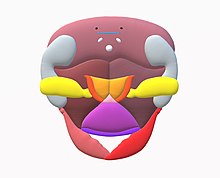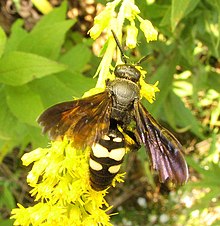The Scoliidae, the scoliid wasps, are a family of about 560 species found worldwide. They tend to be black, often marked with yellow or orange, and their wing tips are distinctively corrugated. Males are more slender and elongated than females, with significantly longer antennae, but the sexual dimorphism is not as apparent as in the Tiphiidae.
Biology
Scoliid wasps are solitary parasitoids of scarab beetle larvae. Female scoliids burrow into the ground in search of these larvae and then use their sting to paralyze them. They will sometimes excavate a chamber and move the paralyzed beetle larva into it before depositing an egg. Scoliid wasps act as important biocontrol agents, as many of the beetles they parasitize are pests, including the Japanese beetle. Male scoliids patrol territories, ready to mate with females emerging from the ground. Adult wasps may be minor pollinators of some plants and can be found on many wildflowers in the late summer.
Scoliidae also has at least one species known to engage in pseudocopulation with an orchid. Flowers of the orchid Bipinnula penicillata in subtropical South America resemble females of Pygodasis bistrimaculata, tricking male wasps into attempting to mate and, in the process, provide pollination.[1] Scoliids include some of the largest wasps in the world, such as Megascolia procer.[2]
Taxonomy
Living scoliidae genera are classified as follows:[3][4][5]
-
Aelocampsomeris Bradley 1957
-
Aureimeris Betrem, 1972
-
Australelis Betrem, 1962
-
Campsomeriella Betrem, 1941
-
Campsomeris Lepeletier, 1838
-
Cathimeris Betrem, 1972
-
Charimeris Betrem, 1971
-
Colpa Dufour, 1841
-
Colpacampsomeris Betrem, 1967
-
Crioscolia Bradley, 1951
-
Dasyscolia Bradley, 1951
-
Dielis Saussure & Sichel, 1864
-
Extrameris Betrem, 1972
-
Guigliana Betrem, 1967
-
Laevicampsomeris Betrem, 1933
-
Leomeris Betrem, 1972
-
Lissocampsomeris Bradley, 1957
-
Megacampsomeris Betrem, 1928
-
Megameris Betrem, 1967
-
Micromeriella Betrem, 1972
-
Peltatimeris Betrem, 1972
-
Phalerimeris Betrem, 1967
-
Pseudotrielis Betrem, 1928
-
Pygodasis Bradley, 1957
-
Radumeris Betrem, 1962
-
Rhabdotimeris Bradley, 1957
-
Sericocampsomeris Betrem, 1941
-
Sphenocampsomeris Bradley, 1957
-
Stygocampsomeris Bradley, 1957
- Tenebromeris Betrem, 1963
-
Trisciloa Gribodo, 1893
-
Tristimeris Betrem, 1967
-
Tubatimeris Betrem, 1972
-
Tureimeris Betrem, 1972
-
Xanthocampsomeris Bradley, 1957
The subfamily Archaeoscoliinae is known exclusively from the fossil record, with the largest diversity having lived during the Cretaceous (Barremian) before going extinct by the late Eocene (Priabonian).
Three additional undescribed specimens from the Ypresian Eocene Okanagan Highlands were referred to the subfamily by S. Bruce Archibald et al. (2018). The two fossils from the Klondike Mountain Formation of Northeastern Washington state, and one fossil from the Allenby Formation of South central British Columbia were mentioned briefly but no specific commentary on placement or finer taxonomic detail was presented in the paper.[12]
History
In 1847 and 1849 Eduard Eversmann published his "Fauna Hymenopterologica Volgo-Uralensis—exhibiting the species of Hymenoptera which he observed and described in the provinces situated between the Volga river and the Ural mountains." He places the Scoliadae LATR. as a subfamily of the Sphegidae LATR. He mentions the genus Scolia FABR., with 13 species, the genus Tiphia FABR. (3 species) and the genus Meria ILL, with only the species Meria sexpunctata.[13]
North American species list

Face of a scoliid wasp in coded color, illustrating the main features:
ocellar pits
ocellar furrow
three simple eyes
two compound eyes
vertex, above curved carina frontalis
frons, below curved carina frontalis and bisected by fissura frontalis
scrobe
area frontalis
clypeus
anterior margin of clypeus
mandibles
antennal scapes
lamina frontalis
spatium frontale or frontal space
Adapted from K. V. Krombein (1978)
[14]
There are about 20 species in North America north of Mexico.[15] Species include:
References
-
^ Ciotek, Liliana; Giorgis, Pablo; Benitez-Vieyra, Santiago; Cocucci, Andrea A. (2005). "First Confirmed Case of Pseudocopulation in Terrestrial Orchids of South America". Flora - Morphology, Distribution, Functional Ecology of Plants. 201 (5): 365–369. doi:10.1016/j.flora.2005.07.012.
-
^ Sarrazin, Michaël; Vigneron, Jean Pol; Welch, Victoria; Rassart, Marie (2008-11-05). "Nanomorphology of the blue iridescent wings of a giant tropical wasp Megascolia procer javanensis (Hymenoptera)". Physical Review E. 78 (5): 051902. arXiv:0710.2692. Bibcode:2008PhRvE..78e1902S. doi:10.1103/PhysRevE.78.051902. PMID 19113150. S2CID 30936410.
-
^ Osten, T. (2005). "Checkliste der Dolchwespen der Welt (Insecta: Hymenoptera, Scoliidae). Teil 1: Proscoliinae und Scoliinae: Campsomerini. Teil 2: Scoliinae: Scoliini. Teil 3: Literatur" [Checklist of the Scoliidae of the World. Part 1: Proscoliinae and Scoliinae: Campsomerini. Part 2: Scoliinae: Scoliini. Part 3: Literature] (PDF). Bericht der Naturforschenden Gesellschaft Augsburg (in German). 62 (220–221): 1–62. Retrieved 2014-06-24.
-
^ "Classification and checklist of Afrotropical mammoth wasps". Retrieved 2019-07-18.
-
^ "BugGuide - Family Scoliidae". Retrieved 2019-07-18.
-
^ "Fauna Europaea". Archived from the original on March 5, 2016.
-
^ a b c d e f g Rasnitsyn, A. (1993). "Archaescoliinae, an extinct subfamily of scoliid wasps (Insecta: Vespida = Hymenoptera: Scoliidae)". Journal of Hymenoptera Research. 2: 85–96.
-
^ a b c Rasnitsyn, A.; Martínez-Delclòs, X. (1999). "New Cretaceous Scoliidae (Vespida=Hymenoptera) from the Lower Cretaceous of Spain and Brazil". Cretaceous Research. 20 (6): 767–772. Bibcode:1999CrRes..20..767R. doi:10.1006/cres.1999.0181.
-
^ Osten, T. (2007). "Hymenoptera: bees, wasps and ants". The Crato Fossil Beds of Brazil: Window into an Ancient World. pp. 350–365.
-
^ a b c Zhang, J. (2004). "New representatives of Cretoscolia (Insecta: Hymenoptera: Scoliidae) from eastern China". Cretaceous Research. 25 (2): 229–234. Bibcode:2004CrRes..25..229Z. doi:10.1016/j.cretres.2003.12.003.
-
^ Zhang, H.; Rasnitsyn, A.; Zhang, J. (2002). "The oldest known scoliid wasps (Insecta, Hymenoptera, Scoliidae) from the Jehol biota of western Liaoning, China". Cretaceous Research. 23 (1): 77–86. Bibcode:2002CrRes..23...77H. doi:10.1006/cres.2001.0302.
-
^ Archibald, S. B.; Rasnitsyn, A. P.; Brothers, D. J.; Mathewes, R. W. (2018). "Modernisation of the Hymenoptera: ants, bees, wasps, and sawflies of the early Eocene Okanagan Highlands of western North America". The Canadian Entomologist. 150 (2): 205–257. doi:10.4039/tce.2017.59. ISSN 0008-347X. S2CID 90017208.
-
^ Eversmann, Eduard (1847). "Fauna Hymenopterologica Volgo-Uralensis I". Bulletin de la Société impériale des naturalistes de Moscou (in Latin). 20 (1): 3–68. (families Tenthredinidae and Uroceratae) and Eversmann, Eduard (1849). "Fauna Hymenopterologica Volgo-Uralensis II". Bulletin de la Société impériale des naturalistes de Moscou (in Latin). 22 (3): 359–436.(family Sphegidae)
-
^ Krombein, Karl V. (1978). "Biosystematic Studies of Ceylonese Wasps, II: A Monograph of the Scoliidae (Hymenoptera: Scolioidea)" (PDF). Smithsonian Contributions to Zoology (283): 6–7. Retrieved 24 September 2021.
-
^ Poole, R.W.; Gentili, P. (1996). "Hymenoptera" (PDF). Nomina Insecta: A Check List of the Insects of North America Nearctica. 2: 309–375. ISBN 1-889002-02-X. Retrieved 2011-10-10.




